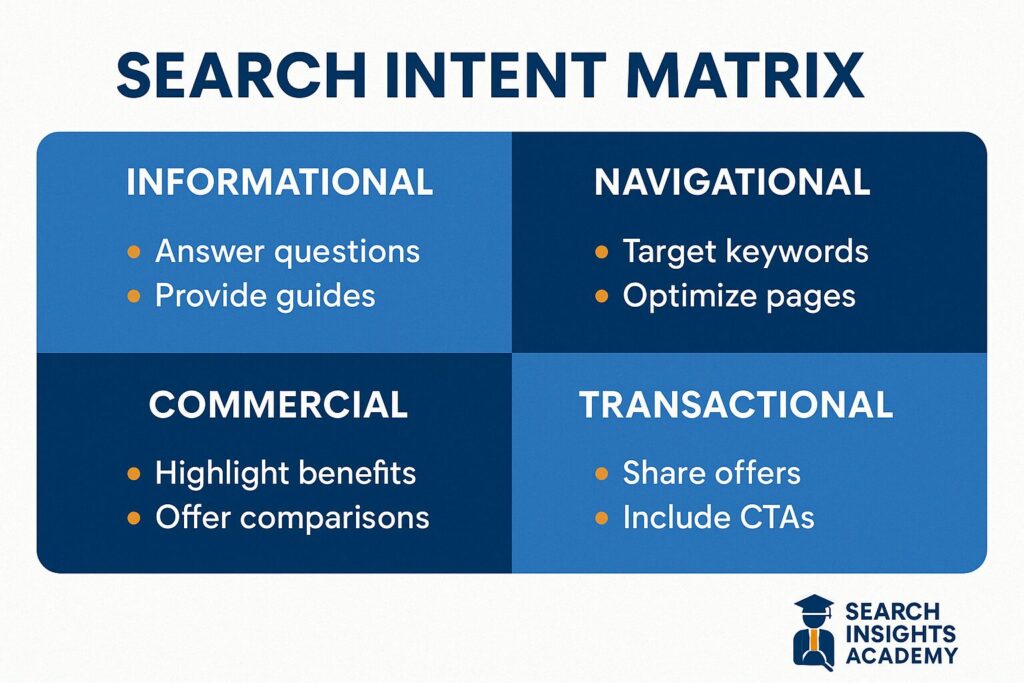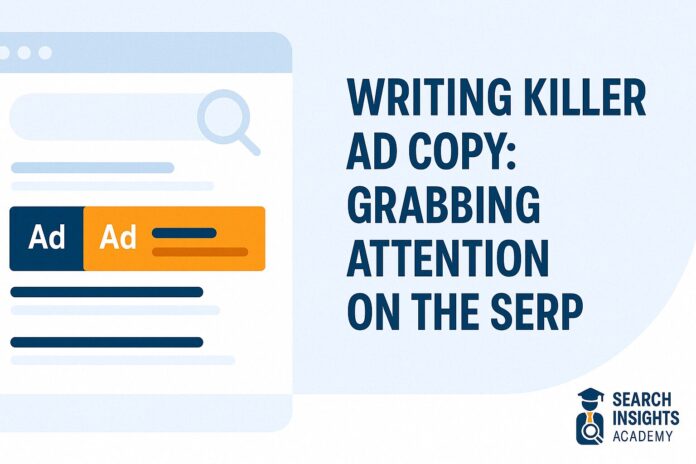In the digital marketing battlefield, your ad copy is often the deciding factor between a click and a scroll-past. Exceptional advertising copy doesn’t just catch the eye—it compels action, speaks directly to user needs, and delivers measurable results.
The search engine results page (SERP) has become prime real estate where businesses compete for attention. Whether someone is searching on Google, browsing Facebook, or scrolling through Instagram, powerful copy transforms casual viewers into engaged customers.
In this comprehensive guide, we’ll explore the art and science of creating high-converting ad copy. From pinpointing your audience’s deepest needs to crafting irresistible headlines and testing various approaches, you’ll discover practical techniques used by successful marketers worldwide. By the end, you’ll have actionable strategies to elevate your advertising copywriting skills across multiple platforms and campaigns.
Introduction: Why Killer Ad Copy Matters on the SERP
Search Engine Results Pages represent the modern marketplace where businesses live or die by their ability to stand out. With users making split-second decisions about where to click, your ad copy needs to work extraordinarily hard in minimal space.
Understanding the Power of High-Converting Ads
High-converting ads don’t happen by accident. They’re carefully crafted messages that align perfectly with user search intent while offering clear value propositions. According to WordStream, the average conversion rate across industries for Google Ads is just 3.75% on the search network. Businesses with compelling ad copy consistently outperform this benchmark, sometimes achieving conversion rates two or three times higher.
Aligning Copywriting with User Intent
Understanding why someone searches for a particular term is fundamental to creating effective ad copy. A person searching for “emergency plumber” has different intent than someone looking for “bathroom renovation ideas.” Your copy must immediately signal that you understand their specific need. Search Engine Journal reports that ads matching search intent can improve quality scores, which lowers cost-per-click while improving ad position.
The Basics: What Is Advertising Copy?

Advertising copy encompasses all the text designed to persuade readers to take a specific action. From headlines and descriptions to calls-to-action, every word serves a strategic purpose in the customer journey.
Defining “Advertising Copy” in Modern Marketing

Today’s advertising copy lives across multiple platforms and formats—each with unique constraints and opportunities. Whether it’s a 30-character headline in Google Ads, an attention-grabbing Facebook post, or compelling Instagram caption, effective copy distills your value proposition into its most potent form. According to HubSpot’s research, 73% of consumers say they pay attention to a brand’s message when they’re interested in the brand’s category.
The Role of Copywriting in Advertising and Copywriting Campaigns
Copywriting is the engine that powers advertising campaigns. While visual elements catch the eye, it’s the words that drive understanding, create emotional connections, and prompt action. Copyblogger notes that copywriting should work like a conversion funnel—drawing readers in with compelling headlines, building interest with relevant details, creating desire through benefits, and driving action with clear CTAs.
Why Good Copywriting Ads Stand Out
In the sea of digital content, standout copy creates a pattern interrupt—something that makes users pause their scroll and pay attention. According to Nielsen Norman Group, users typically read just 20-28% of words on a webpage during an average visit. Good copy acknowledges this behavior by front-loading value and using powerful language that creates immediate recognition of relevance.
Identifying Your Audience
Before writing a single word of ad copy, you must understand who you’re speaking to. Audience research provides the foundation for every successful ad campaign.
Researching Consumer Pain Points

Great copy addresses specific problems that keep your audience up at night. Conversion XL emphasizes that understanding pain points is critical for creating compelling value propositions. Review platforms like Trustpilot, Reddit threads, and industry forums can provide goldmines of information about what frustrates your potential customers and what solutions they’re actively seeking.
Tailoring Your Message for Local Markets
While global brands need universal appeal, local nuances can significantly impact engagement. Cultural references, regional terminology, and location-specific concerns should inform your copy when targeting defined geographic areas. For example, messaging about winter heating solutions would vary drastically between Miami and Minneapolis. Think with Google reports that 76% of people who search on their smartphones for something nearby visit a business within a day.
Crafting Headlines & Descriptions That Convert
Headlines determine whether your ad gets noticed, while descriptions convince users you have what they need. Mastering both elements is essential for SERP success.
Using Emotional Hooks in Best Copywriting Ads

Emotions drive decisions far more than logic does. Buffer’s research found that content that evokes high-arousal emotions like awe, anger, or anxiety is more likely to be shared and engaged with. Headlines that tap into fundamental emotional triggers—curiosity, fear of missing out, desire for improvement—consistently outperform neutral statements.
Consider these emotionally-charged examples:
- “Stop Wasting Money on Ineffective Marketing Tactics”
- “The Little-Known Strategy That Doubled Our Conversion Rate”
- “Why Your Competitors Are Stealing Your Customers (And How to Stop Them)”
Leveraging Keywords and Power Words

Strategic keyword placement signals relevance to both search engines and users. Backlinko recommends including your target keyword in the headline while keeping it natural and engaging. Power words—terms like “exclusive,” “proven,” “instant,” or “guaranteed”—add emotional impact and urgency when used appropriately.
Effective power word examples:
- “Exclusive Access: The Ultimate Guide to PPC Success”
- “Guaranteed Results: Our Proven Framework for Higher Conversions”
- “Instantly Improve Your Click-Through Rate With These 5 Tactics”
Creating Strong Value Propositions in Descriptions
After your headline captures attention, your description must quickly establish what makes your offering uniquely valuable. Unbounce emphasizes that effective value propositions clearly communicate what problem you solve and why you’re the best solution. Your description should answer the critical question: “What’s in it for me?”
Compelling description examples:
- “Our data-driven approach has helped over 500 businesses reduce ad spend while increasing conversions. Free consultation available today.”
- “Join 10,000+ marketers who’ve boosted their CTR by 27% with our step-by-step template. Download instantly—no email required.”
- “Trusted by Fortune 500 companies and startups alike. Our platform automates your reporting, saving 5+ hours weekly while improving accuracy.”
Character Count Optimization
Platform-specific constraints must guide your copywriting. For Google Ads, headlines are limited to 30 characters each, while descriptions can be up to 90 characters per line. According to Adalysis research, ads that use all available headline space tend to perform better than those that don’t maximize character counts.
Writing Effective Ads: Core Principles
Effective ad copy follows fundamental principles that work across platforms and industries. Understanding these principles provides a framework for consistently creating high-performing ads.
Structuring Ad Copy for Maximum Impact

According to Content Marketing Institute, the most effective ad structure follows a proven formula: identify a problem, agitate it, then present your solution (Problem-Agitate-Solve). This structure creates emotional resonance before offering relief through your product or service.
The Importance of Clarity, Brevity, and Relevance
Digital attention spans continue to shrink. Microsoft research suggests the average attention span is now just 8 seconds. Your copy must communicate value instantly through:
- Clear, jargon-free language
- Concise sentences and paragraphs
- Immediate relevance to search intent
Good Sales Copy vs. Great Copywriting Ads: Key Differences
While “good” copy might generate adequate results, truly exceptional copy creates memorable impressions that drive action. Copyhackers identifies several differentiators between average and outstanding copy:
- Good copy explains features; great copy translates features into benefits
- Good copy follows conventions; great copy surprises in delightful ways
- Good copy speaks to audiences; great copy speaks to individuals
Designing Ad Copy: Beyond the Text
Visual elements and design choices significantly impact how your copy performs. The most compelling message can fall flat without appropriate visual support.
Visual Elements and Calls-to-Action
According to Unbounce, CTAs that stand out visually through color contrast can improve click-through rates by up to 32%. The placement, size, and visual treatment of your CTA should guide the eye naturally from your headline through your description to the desired action.
Best Practices for Ad Copy Design

Nielsen Norman Group research shows that users typically scan content in an F-pattern, focusing most attention on the top and left side of content. Design your ad copy layout to accommodate this pattern by:
- Placing key information at the beginning of headlines
- Using bulleted lists for important features/benefits
- Including visual cues that direct attention to CTAs
Sample of Advertising Copy: Formats and Layouts
Different platforms require different formats. For example:
Google Search Ad:
- Headline 1: Professional Resume Services (30 char)
- Headline 2: Stand Out to Employers | 24hr Turnaround (30 char)
- Headline 3: 98% Interview Success Rate (30 char)
- Description 1: Our certified writers help you land interviews with ATS-optimized, custom resumes tailored to your industry. (90 char)
- Description 2: Free consultation. 100% satisfaction guarantee. Trusted by 50,000+ professionals worldwide. (89 char)
Facebook Ad:
- Headline: Land Your Dream Job in 30 Days
- Primary Text: Tired of sending resumes into the void? Our clients get 3X more interviews with our professionally crafted, ATS-optimized resumes. Industry-specific templates that highlight your unique strengths.
- Description: Professional Resume Services with 98% Success Rate
- CTA Button: Learn More
A/B Testing Ad Variations

Even experienced copywriters can’t predict with absolute certainty which ad versions will perform best. Systematic testing is essential for optimization.
Elements Worth Testing in Ad Copy
WordStream suggests focusing your testing efforts on elements that typically drive the biggest performance differences:
- Headlines (different value propositions, emotional appeals, or offers)
- CTAs (action verbs, urgency elements, or benefit-focused language)
- Description approaches (problem-focused vs. solution-focused)
- Feature vs. benefit emphasis
- Different qualifying language (who the offer is best for)
Setting Up Effective A/B Tests
For statistically significant results, follow these testing principles from CXL:
- Test only one element at a time for clear causation
- Run tests until you reach 95% confidence or higher
- Ensure adequate sample sizes (typically 1,000+ impressions per variation)
- Account for time-based variables by running tests for full business cycles
Interpreting Test Results for Continuous Improvement
Beyond simple winners and losers, extract deeper insights from your tests. Google Ads recommends analyzing:
- Performance across different audience segments
- Device-specific performance differences
- Time-of-day or day-of-week patterns
- How different ad elements impact various stages of the funnel
Apply these learnings not just to the tested ads but across your marketing messaging for compound improvements.
Relevance Between Ad Copy & Landing Page

The journey doesn’t end when someone clicks your ad. Maintaining message consistency between ad and landing page is crucial for conversions.
The Message Match Principle
Instapage research shows that strong message match—where landing pages directly reflect the language and promises made in ads—can improve conversion rates by up to 25%. Key elements to align include:
- Headlines and main value propositions
- Visual identity and branding elements
- The specific offer mentioned in the ad
- Target audience language and terminology
Creating Seamless User Journeys
The transition from ad to landing page should feel natural and expected. Unbounce advocates for conversion-centered design principles that guide visitors logically from interest to action:
- Maintain visual continuity between ad and landing page
- Reinforce the same key benefits highlighted in the ad
- Address anticipated questions that arose from the ad copy
- Provide social proof that validates ad claims
- Streamline the path to conversion with minimal distractions
How Message Consistency Impacts Quality Score and Ad Rank
Beyond conversion benefits, message match significantly affects ad performance metrics. Google confirms that landing page experience is a key component of Quality Score, which influences:
- Ad rank in the auction
- Cost-per-click
- Ad position
- Overall campaign efficiency
Ads pointing to highly relevant landing pages tend to achieve better quality scores, creating a virtuous cycle of lower costs and better placement.
How to Write a Good Facebook Ad

Facebook’s unique environment offers different challenges and opportunities than search advertising. Understanding the platform’s specific best practices is essential for success.
The Core Elements of Facebook Ad Writing
According to Facebook Business, effective Facebook ads typically incorporate:
- Primary text that captures attention quickly (125 characters often display before “See More”)
- An engaging headline (40 characters or less recommended)
- A brief description that reinforces the main message
- A clear, action-oriented CTA button
“How to Write Good Facebook Ad Copy?”: Step-by-Step Guide
AdEspresso’s analysis of 37,259 Facebook ads revealed best practices for maximizing engagement:
- Start with a question or statement that relates to a specific pain point
- Use data points or social proof early in your copy
- Keep sentences and paragraphs short for better mobile readability
- Incorporate casual, conversational language that mimics how friends communicate
- Create a sense of exclusivity or urgency when appropriate
- End with a crystal-clear next step
Common Pitfalls to Avoid on Facebook
Social Media Examiner warns against these frequent Facebook ad mistakes:
- Using corporate language instead of conversational tone
- Creating ads that feel like ads rather than native content
- Neglecting to address the “why should I care?” question immediately
- Over-promising or using hyperbole that damages credibility
- Failing to segment audiences for more targeted messaging
Quick-Win Strategies for Low-Hanging Fruit Keywords

For immediate results, focus first on keywords with lower competition but strong intent. These opportunities often provide the fastest return on investment.
Targeting Niche Markets and Untapped Opportunities
Ahrefs research suggests that long-tail keywords (3+ words) typically have lower competition while demonstrating higher purchase intent. Instead of competing for broad terms like “marketing services,” consider more specific variations like “B2B content marketing services for SaaS” or “social media management for dentists.”
Writing Effective Ads for Budget-Friendly Campaigns
When budgets are limited, efficiency becomes paramount. PPC Hero recommends these copywriting approaches for cost-effective campaigns:
- Incorporate qualifying language that filters out non-ideal prospects before they click
- Focus on immediate, tangible benefits rather than broad brand promises
- Include specific pricing or offer details to pre-qualify clicks
- Test lower-competition dayparts or geographic regions first
High-Traffic Keywords and SEO Integration
Once you’ve mastered low-hanging fruit opportunities, strategic approaches to competitive keywords can expand your reach substantially.
Choosing the Right Keywords for Best Advertising Copy
Moz advocates evaluating keywords through a balanced consideration of:
- Search volume: How many people search for this term monthly?
- Competition level: How difficult is it to rank for this term?
- Commercial intent: How likely are searchers to convert?
- Relevance: How closely does the term align with what you offer?
Writing Ads That Rank: Copywriting in Advertising and SERP Goals
For competitive terms, Search Engine Land suggests these techniques for improving Quality Score and ad position:
- Include the exact keyword in your headline when possible
- Address the primary intent behind the search directly
- Use ad extensions strategically to provide additional information
- Achieve high clickthrough rates through compelling offers and emotional hooks
- Ensure strong relevance between ad copy and landing page
Addressing “People Also Ask” and Common Pain Points
Anticipating and addressing frequent questions in your ad copy demonstrates understanding and builds trust with potential customers.
What Is Advertising Copy? (Revisited)

Advertising copy is persuasive text designed to drive specific actions from readers. According to Copyblogger, effective copy combines psychological understanding with clear communication to create messages that resonate deeply with target audiences.
How to Write Advertising Copy for ROI-Focused Campaigns
Marketing Experiments found that ROI-focused campaigns perform best when copy emphasizes:
- Specific, measurable outcomes over vague promises
- Concrete numbers and percentages that quantify benefits
- Time frames for expected results
- Comparisons to current performance or industry benchmarks
- Risk reduction elements like guarantees or free trials
Balancing Search Intent with Audience Needs
Wordtracker recommends categorizing keywords by search intent (informational, navigational, commercial, transactional) and then aligning copy accordingly:
- Informational searches: Position yourself as a trusted advisor with educational content
- Commercial searches: Focus on comparisons, reviews, and differentiators
- Transactional searches: Emphasize ease of purchase, availability, and special offers
Conclusion: Putting It All Together

Creating killer ad copy for SERPs isn’t a mysterious art—it’s a learnable skill built on understanding your audience, crafting compelling messages, and continuously testing and refining your approach.
Exceptional ad copy bridges the gap between search queries and solutions. It speaks to real human needs while satisfying algorithmic requirements. By focusing first on user intent and then incorporating proven copywriting techniques, you’ll create ads that not only attract clicks but drive meaningful conversions.
The digital landscape continues to evolve, but the fundamentals of persuasive communication remain constant. Whether you’re writing for Google, Facebook, LinkedIn, or emerging platforms, the principles outlined in this guide will help you create advertising copy that connects, convinces, and converts.
Remember to approach each campaign with a testing mindset. The most successful digital marketers aren’t those who get everything perfect on the first try, but those who systematically discover what resonates with their specific audiences through deliberate experimentation and optimization.
What ad copywriting techniques have worked best for your campaigns? Share your experiences in the comments below!Add to Conversation


